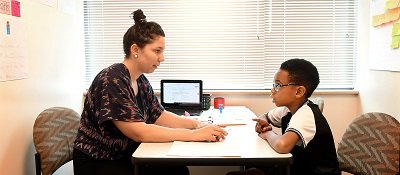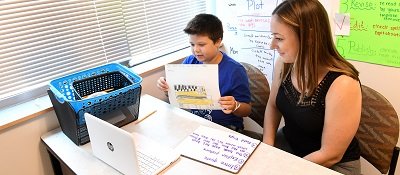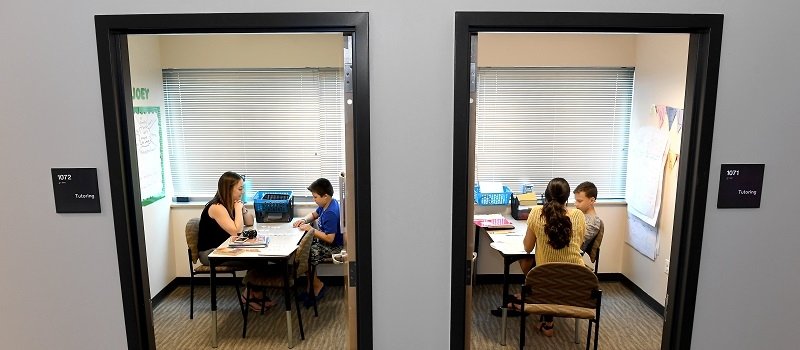80 years of building better readers
80 years of building better readers
The story, Erin Moles admitted, “was all over the place.”
But that didn’t matter. What did matter was that her tutee--a shy second grader who was struggling with reading comprehension--was creating a fantastical story about a courageous crab that fends off a zombie at the seashore.
As Moles listened attentively and helped him get his thoughts on the page, he walked—and sometimes wiggled—around the room, writing his tall tale.
“If he needs to move in order to talk with me, then he needs to do that. So I try to get him up and moving,” Moles said.
“Right now, his story doesn’t have a beginning, a middle and an end,” she continued. “So I’ll work with him on character development, setting, the problem and the solution. I’m going to have him read it to see if it makes sense.”
Using index cards, the pair arranged and rearranged sentences, adding and subtracting as necessary until his story flowed.
“He was able to rearrange and take out sentences that didn’t make sense,” Moles said, adding that, after writing, rewriting and careful contemplation, her tutee ultimately decided to make the zombie a bit character in the story.
“He also added some more sentences to make it flow better. The approach was more effective than drafting a story on paper and pencil because he didn’t have to do a lot of erasing and rewriting. Working from the sentences he wrote on index cards, he copied the story for his final draft.”
A leg up
At the end of their 16 sessions together this summer in the Rowan University Reading Clinic, Moles’s tutee had a book of his own with story and illustration done entirely by him—an accomplishment he relished.
He also had a leg up on his second grade year. Moles deftly made sure of that, working in reading, comprehension, word work and fluency in every lesson. That’s the goal of the Reading Clinic, housed in Rowan University’s James Hall, the home of the College of Education.
Now in its 80th year and established just 16 years after the University’s founding, the year-round clinic has served as a community center for reading improvement for thousands of students in kindergarten through 12th grades. Rowan education majors--undergraduate literacy studies majors as well as graduate students pursuing reading specialist certification—are the tutors, providing critical one-to-one instruction to struggling readers.
In turn, tutors learn to become stronger, better teachers. After an initial reading assessment of each child conducted by Reading Clinic Coordinator Janet Iles, tutors zero in on areas where readers struggle, making formal lesson plans to address problem areas. At the end of each 20-hour tutoring clinic, tutors write extensive reports that include strategies and recommendations to further assist readers.
In many cases, readers return for multiple sessions. The fall and spring Reading Clinic sessions run after school for an hour twice weekly. The fee is $325 for a full, 20-hour clinic cycle. If a student returns for a consecutive cycle, the next cycle is $250. There’s a $50 discount for an additional sibling.
The fall clinic begins this year on Wednesday, Sept. 18, and runs through Dec. 2. Sixty tutors—one of the biggest group of tutors in recent memory—will be available to work with children in the bright, friendly clinic in the fall.
The summer Reading Clinic, which recently concluded, ran Monday-Thursday for 16, 90-minute morning sessions.
“The purpose of our instruction is to help children be better readers and writers,” says Iles. “Reading is the most important skill children can learn. As our society changes and we get away from hard print, kids learn to like short bursts of information. To be able to sustain their thinking while reading is something they really struggle with.”
Individualized instruction
To help her tutee, Moles developed lesson plans that included art, one of his big interests. Moles is a senior elementary education and literacy studies major pursuing the Thomas N. Bantivoglio Honors Concentration in the Honors College.
As veteran teachers know, she quickly discovered that she had to be flexible and to think on her feet during tutoring sessions. But she also saw the impact of working one-to-one with a child.
“I’ll write whole lesson plans and we might only get one thing done,” she said, noting a single lesson plan might take her four hours to write. “Our professors tell us, ‘Don’t worry about getting everything done A to B to C to D. Make sure he’s getting the objective. If he does, he’s moving along.’
“What resonates with me here in the clinic is the individuality of each student. Each room in the clinic is different and each instruction is different.”
 That’s by design, Iles said.
That’s by design, Iles said.
“You don’t get individualized instruction like this anywhere else. We have fought against instituting group instruction,” said Iles, adding that the undergraduate and graduate reading programs in the College of Education are accredited by the National Council for Accreditation in Teacher Education. “The clinic nurtures the language experience all children need to grow intellectually, socially and emotionally in the classroom.”
Impressive strategies
That’s what led Franklinville mom Dina Cook, a middle school teacher, to the summer Reading Clinic. Her two sons, ages eight and six, both attended the clinic.
“Their tutors found them books they relate to, like and are interested in,” said Cook, whose husband attended the reading clinic some 30 years ago. “They’re really excited about reading now. I’m seeing changes in their habits. My younger one wants to read all day, every day. He now has a real love of reading. I see my older son reading more now as well.”
The clinic’s welcoming environment was a real plus for the boys, said Cook, who saw some teaching techniques used by tutors that she also can use in her classroom.
“I was impressed by some of their strategies,” Cook said.
As their final summer session ended, Moles saw growth in her tutee, she said.
“I saw improvement in his fluency,” she explained. “At the beginning of the sessions, he wasn’t paying too much attention to punctuation or emotion. But by the last session, he’d read with emotion and he was able to identify the emotion a character was feeling in a story when I asked him.
“He also improved in word study,” Moles continued, noting that her tutee began using decoding techniques he was taught in the clinic. “By the end, he applied a variety of different strategies I taught him to decode or figure out a word in a text. I could tell that he was thinking about the meaning of the text to identify an unfamiliar word, which is great for comprehension.
“It was an honor for me to work with him,” she added. “And it’s a privilege to have this practice for the future.”
